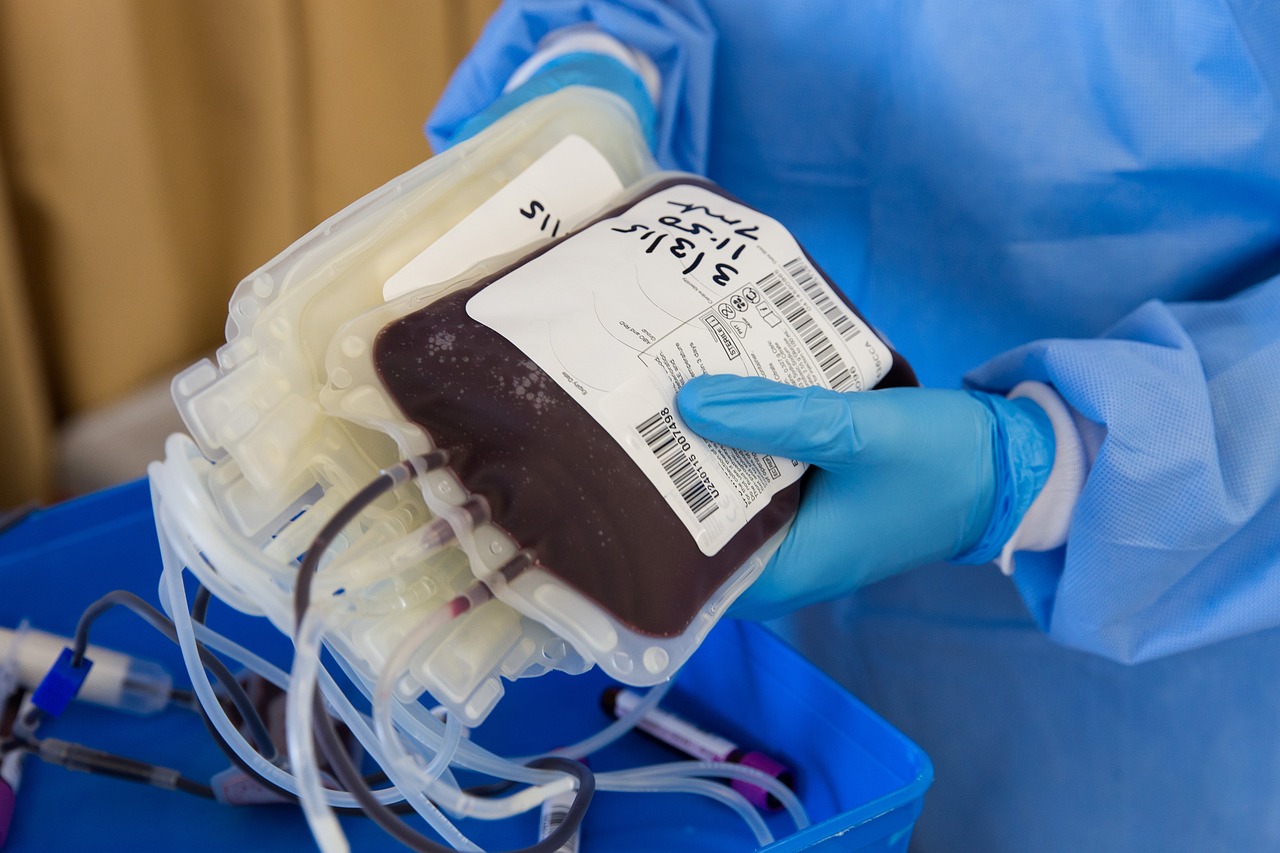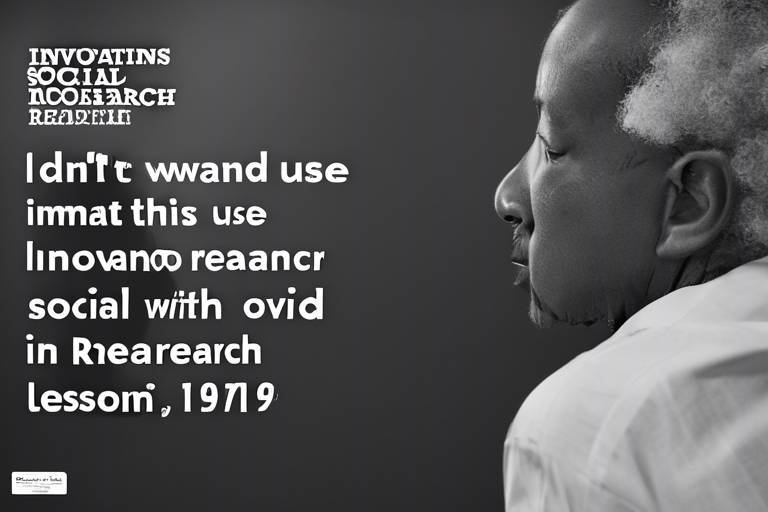Using Case-Control Studies for Causation Insights
In the realm of research, understanding causation is akin to piecing together a complex puzzle. Case-control studies serve as a pivotal tool in this endeavor, allowing researchers to investigate the links between exposures and outcomes in a structured manner. These studies are particularly valuable because they enable scientists to delve into the past experiences of individuals, comparing those affected by a particular condition to those who are not. This comparative approach opens the door to uncovering potential risk factors and understanding the underlying mechanisms of various health issues.
Imagine you're a detective trying to solve a mystery. You have a group of individuals who have experienced a certain event (the cases) and a group who have not (the controls). By examining the differences in their histories, you can start to form hypotheses about what might have caused the event. This is precisely what case-control studies do, and their significance cannot be overstated. They provide a framework for exploring causal relationships in situations where randomized controlled trials may be impractical or unethical.
One of the most compelling aspects of case-control studies is their ability to focus on rare diseases or conditions. Since these conditions occur infrequently, it would be inefficient and costly to conduct a study that follows a large cohort over time. Instead, researchers can select a smaller group of cases and find appropriate controls, allowing them to gather meaningful data without the need for extensive resources. This efficiency is crucial in public health research, where timely insights can lead to effective interventions.
Despite their advantages, it's essential to recognize that case-control studies are not without limitations. They often grapple with issues such as recall bias, where participants may struggle to accurately remember past exposures, leading to skewed results. Moreover, while these studies can suggest associations, establishing definitive causation is a complex challenge. It’s like trying to prove that a shadow is cast by a specific object when multiple sources of light may exist. Therefore, researchers must approach their findings with caution and consider them as part of a broader body of evidence.
In conclusion, case-control studies are a vital component of epidemiological research, providing insights that can inform public health policies and clinical practices. By understanding their methodology, advantages, and limitations, researchers can harness the power of these studies to uncover the intricate relationships between exposures and health outcomes. As we continue to navigate the complexities of health research, case-control studies will undoubtedly remain a cornerstone in our quest for knowledge.
- What is a case-control study? A case-control study is an observational research design that compares individuals with a specific condition (cases) to those without it (controls) to identify potential risk factors.
- How are cases and controls selected? Cases are typically individuals diagnosed with the condition of interest, while controls are selected from the same population but do not have the condition. Selection strategies aim to minimize bias.
- What are the main advantages of case-control studies? They are particularly efficient for studying rare diseases and are often more cost-effective than other study designs, such as cohort studies.
- What are the limitations of case-control studies? Limitations include the potential for recall bias and the difficulty in establishing definitive causation from observed associations.
- In what fields are case-control studies commonly used? They are widely used in public health, clinical research, and epidemiology to identify risk factors and evaluate treatment outcomes.

Understanding Case-Control Studies
Case-control studies are a pivotal component of epidemiological research, serving as a powerful tool for understanding the relationship between exposures and outcomes. At their core, these studies compare individuals diagnosed with a specific condition, known as cases, to those who do not have the condition, referred to as controls. This design allows researchers to identify potential risk factors and associations that may contribute to the development of diseases.
The primary purpose of a case-control study is to determine whether exposure to a certain risk factor is associated with an increased likelihood of a specific outcome. For instance, if researchers are investigating the potential link between smoking and lung cancer, they would compare a group of lung cancer patients (the cases) to a group of individuals without lung cancer (the controls). By analyzing the differences in exposure histories between these two groups, researchers can infer whether smoking is a significant risk factor for lung cancer.
One of the most compelling aspects of case-control studies is their ability to uncover associations in a relatively short time frame. Unlike cohort studies, which may take years to yield results due to the need to follow participants over time, case-control studies can be conducted more quickly. This efficiency is particularly beneficial when dealing with rare diseases or conditions, where finding a sufficient number of affected individuals can be challenging.
However, the design of case-control studies is not without its complexities. Researchers must carefully define their cases and controls to ensure that the comparisons made are valid. This involves selecting cases that accurately represent the population of interest and controls that are comparable in other aspects, such as age, sex, and socio-economic status. The goal is to minimize bias and confounding variables that could skew the results.
In summary, case-control studies are an essential method for exploring causation in epidemiological research. They provide valuable insights into the potential relationships between exposures and outcomes, particularly in the context of rare diseases. By understanding the strengths and limitations of this study design, researchers can harness its power to inform public health decisions and clinical practices.

Methodology of Case-Control Studies
Case-control studies are a fundamental tool in epidemiological research, allowing scientists to investigate the relationship between exposures and outcomes. The methodology of these studies is structured yet flexible, enabling researchers to adapt their approach based on the specific condition or disease being studied. At the heart of a case-control study lies the comparison between two groups: those with the condition (cases) and those without (controls). This comparison is crucial for identifying potential risk factors that may contribute to the development of the disease.
To conduct a successful case-control study, researchers follow a series of well-defined steps. First, they must select appropriate cases and controls. This selection process is critical, as it directly influences the validity of the study's findings. Researchers often employ specific criteria to define cases, ensuring they have a clear and consistent definition of the disease. For controls, the goal is to choose individuals who are similar to the cases in every way except for the presence of the disease. This similarity helps to control for confounding variables that could skew results.
Choosing the right cases and controls is paramount for obtaining valid results. Researchers often utilize strategies such as random sampling or matching to enhance the representativeness of their samples. The aim is to minimize bias, which can significantly affect the reliability of the findings. For instance, if cases are drawn from a specific hospital, controls should ideally come from the same hospital or a similar population to ensure comparability.
There are several types of controls that researchers can utilize in case-control studies:
- Population-based controls: These controls are drawn from the general population and are often considered the gold standard because they reflect the background risk of the disease.
- Hospital-based controls: These controls are selected from patients visiting the same hospital for unrelated conditions. While convenient, they may introduce selection bias if the controls have different risk factors compared to the general population.
Each type has its advantages and disadvantages, and the choice depends on the study's goals and context.
Another critical aspect of the methodology is the use of matching techniques. By matching cases and controls based on specific characteristics such as age, gender, or socioeconomic status, researchers can reduce the impact of confounding variables. There are two main types of matching:
- Individual matching: Each case is paired with a control that has similar characteristics.
- Frequency matching: Cases and controls are matched based on the distribution of characteristics within the groups rather than on an individual basis.
While matching can enhance the study's validity, it also adds complexity to the analysis and interpretation of the data.
Data collection is another vital component of case-control studies. Researchers typically gather information through various methods, including surveys, structured interviews, and medical records. The choice of data collection method can significantly influence the quality and accuracy of the data. For instance, surveys may provide valuable insights but can be susceptible to recall bias, where participants may not accurately remember past exposures. Thus, ensuring accurate data collection is paramount, and researchers must be aware of potential challenges that may arise during this process.
In summary, the methodology of case-control studies is designed to provide a robust framework for understanding the relationships between exposures and disease outcomes. By carefully selecting cases and controls, employing effective matching techniques, and utilizing appropriate data collection methods, researchers can uncover valuable insights that contribute to our understanding of causation in health and disease.
Q: What is a case-control study?
A: A case-control study is an observational study design that compares individuals with a specific condition (cases) to those without the condition (controls) to identify potential risk factors or causes.
Q: Why are case-control studies important?
A: They are essential for identifying associations between exposures and outcomes, especially for rare diseases, where other study designs may not be feasible.
Q: What are the main limitations of case-control studies?
A: Limitations include recall bias, selection bias, and the difficulty in establishing definitive causation.
Q: How do researchers select controls in a case-control study?
A: Controls are selected to be similar to cases in all respects except for the disease being studied, often using population-based or hospital-based methods.

Selection of Cases and Controls
Selecting the right cases and controls is a critical step in conducting case-control studies. This selection process can significantly influence the validity and reliability of the study's findings. The aim is to ensure that the cases—individuals with the condition being studied—are comparable to the controls—those without the condition. A well-chosen control group serves as a benchmark, allowing researchers to attribute differences in outcomes specifically to the exposure of interest.
One of the primary strategies for selecting cases involves defining clear inclusion and exclusion criteria. This ensures that the cases are representative of the population that has the condition. For instance, if researchers are studying a rare disease, they might include individuals diagnosed within a specific timeframe or those who meet certain clinical criteria. On the other hand, controls should also be selected using similar criteria to avoid introducing bias. For example, if the cases are selected from a hospital, the controls should ideally come from the same hospital or a similar setting to maintain comparability.
Additionally, researchers must consider the potential for bias during the selection process. Selection bias can occur if the cases and controls are drawn from different populations or if they have different characteristics that could influence the outcome. To minimize this risk, employing strategies such as matching can be beneficial. Matching involves pairing each case with a control that has similar characteristics, such as age, gender, or socioeconomic status. This technique helps to control for confounding variables that could skew the results.
Here’s a brief overview of the types of controls that can be used in case-control studies:
| Type of Control | Advantages | Disadvantages |
|---|---|---|
| Population-Based Controls | More representative of the general population | May be harder to identify and recruit |
| Hospital-Based Controls | Easy to recruit and often readily available | May not represent the general population, leading to bias |
In conclusion, the selection of cases and controls is a vital component of case-control studies. It requires careful planning and consideration to ensure that the results are valid and can be generalized to a broader population. By employing rigorous selection criteria and strategies such as matching, researchers can enhance the reliability of their findings and contribute valuable insights into the causative factors of diseases.
- What is the main purpose of using case-control studies? Case-control studies are primarily used to identify and evaluate risk factors associated with specific diseases or conditions by comparing individuals with the condition to those without.
- How do researchers minimize bias in case-control studies? Researchers minimize bias by carefully selecting cases and controls, using matching techniques, and ensuring that the groups are comparable in terms of relevant characteristics.
- Can case-control studies establish causation? While case-control studies can suggest associations between exposure and outcomes, they cannot definitively establish causation due to potential confounding factors.

Types of Controls
When conducting case-control studies, the choice of controls is paramount. Controls serve as a baseline against which the cases can be compared, helping to identify potential risk factors associated with the condition under study. There are primarily two types of controls that researchers can utilize: population-based controls and hospital-based controls. Each type has its unique advantages and disadvantages, which can significantly influence the outcomes and interpretations of the study.
Population-based controls are selected from the general population, which means they are more likely to represent the broader community. This type of control can help ensure that the findings are applicable to the general public. For instance, if a study is examining a rare disease, having a control group from the same demographic as the cases can yield more relevant insights. However, the challenge lies in the logistical aspects of recruiting participants, as it may be time-consuming and costly.
On the other hand, hospital-based controls are drawn from individuals who seek medical care at the same institution where the cases are identified. This approach can be more practical and feasible, especially when dealing with specific conditions that require hospital treatment. However, this method may introduce biases since the controls might have different health-seeking behaviors compared to the general population. As a result, they may not accurately represent the risk factors present in the broader community.
To illustrate the differences between these two types of controls, consider the following table:
| Type of Control | Advantages | Disadvantages |
|---|---|---|
| Population-based Controls |
|
|
| Hospital-based Controls |
|
|
Ultimately, the choice between population-based and hospital-based controls should be guided by the specific research question and the nature of the disease being studied. Researchers must weigh the benefits and drawbacks of each type of control to ensure the validity and reliability of their findings. By carefully selecting controls, researchers can enhance the quality of their case-control studies and contribute valuable insights into the understanding of causation.
1. What is the main purpose of using controls in case-control studies?
Controls help establish a comparison group that does not have the condition being studied, allowing researchers to identify potential risk factors and associations.
2. How can bias be minimized when selecting controls?
Bias can be minimized by ensuring that controls are representative of the population from which the cases arise and by using random sampling techniques when possible.
3. Are population-based controls always preferred over hospital-based controls?
Not necessarily. The choice depends on the specific study design, the disease in question, and the feasibility of recruiting participants from each group.

Matching Techniques
In the realm of case-control studies, play a pivotal role in ensuring that the cases and controls being compared are as similar as possible, except for the exposure of interest. This similarity is crucial because it helps to minimize the influence of confounding variables—those pesky factors that can skew results and lead to erroneous conclusions. Imagine trying to compare the performance of two athletes; if one is training at high altitude while the other is at sea level, any differences in their performance could be attributed to the environment rather than their skill or training. That's why matching is so important in research.
There are several methods researchers can employ to achieve effective matching. One common approach is individual matching, where each case is paired with a control that shares similar characteristics, such as age, gender, or socioeconomic status. This method allows for a direct comparison that reduces the variability caused by these factors. Alternatively, researchers might opt for frequency matching, where they ensure that the distribution of certain characteristics (like age groups) is similar in both cases and controls, but without pairing individuals directly. This can be particularly useful when dealing with larger datasets where individual matching may become cumbersome.
However, while matching can significantly enhance the validity of a study, it’s not without its challenges. For instance, researchers must be cautious about over-matching, which can lead to a loss of valuable data and reduce the generalizability of the findings. Over-matching occurs when cases and controls are matched too closely, to the point where the differences that might reveal important associations are obscured. Therefore, striking the right balance is key.
To illustrate the different matching techniques and their implications, consider the following table:
| Matching Technique | Description | Advantages | Disadvantages |
|---|---|---|---|
| Individual Matching | Pairing each case with a control based on specific characteristics. | Minimizes variability, provides direct comparisons. | Time-consuming, may lead to over-matching. |
| Frequency Matching | Ensuring similar distribution of characteristics in cases and controls. | More efficient with larger datasets, easier to implement. | Less precise than individual matching, potential for residual confounding. |
Ultimately, the choice of matching technique should align with the study's objectives and the specific characteristics of the population being studied. By carefully considering how to match cases and controls, researchers can bolster the credibility of their findings and contribute to a deeper understanding of the relationships between exposures and outcomes.

Data Collection Methods
Data collection is a pivotal aspect of case-control studies, as the validity of the findings heavily relies on the accuracy and reliability of the data gathered. Researchers employ various methods to collect data from both cases (those with the condition) and controls (those without). The most common methods include surveys, interviews, and the analysis of medical records, each with its unique strengths and challenges.
Surveys are often used to gather quantitative data, allowing researchers to ask participants specific questions about their health history, lifestyle, and potential exposures to risk factors. They can be administered in person, over the phone, or online, providing flexibility in how data is collected. However, the effectiveness of surveys hinges on the participants' ability to recall past exposures accurately. This is where the challenge of recall bias comes into play, as individuals may misremember or omit crucial details, leading to skewed results.
Interviews, on the other hand, offer a more in-depth approach to data collection. They allow researchers to probe deeper into participants' experiences and gather qualitative data that surveys might miss. This method can provide rich, contextual information that enhances understanding of the factors influencing the condition being studied. However, interviews can be time-consuming and require skilled interviewers to ensure consistency and reliability in responses.
Medical records represent another valuable source of data, providing objective information about patients' health history, treatments received, and outcomes. Analyzing these records can yield insights into the prevalence of certain conditions and the effectiveness of various treatments. However, accessing medical records can present ethical and legal challenges, and researchers must ensure they comply with regulations regarding patient confidentiality.
In summary, the choice of data collection method in case-control studies can significantly influence the study's outcomes. Researchers must carefully consider the strengths and weaknesses of each method while also being mindful of potential biases. By employing a combination of these methods, they can enhance the robustness of their findings and contribute valuable insights into the understanding of causation.
- What is a case-control study? A case-control study is an observational research method that compares individuals with a specific condition (cases) to those without it (controls) to identify potential risk factors.
- Why are case-control studies important? They are crucial for identifying associations between exposures and outcomes, particularly in studying rare diseases or conditions.
- What are the main limitations of case-control studies? Key limitations include recall bias, difficulty in establishing causation, and the potential for selection bias.
- How can researchers minimize bias in case-control studies? Researchers can minimize bias by carefully selecting cases and controls, using matching techniques, and employing multiple data collection methods.

Advantages of Case-Control Studies
Case-control studies are a popular choice among researchers for various reasons, primarily their efficiency and cost-effectiveness. These studies are particularly advantageous when it comes to investigating rare diseases or outcomes, allowing researchers to gather meaningful data without needing to recruit large cohorts. Imagine trying to find a needle in a haystack; case-control studies help you focus on the right sections of the haystack where the needles are more likely to be found. By comparing individuals with a specific condition (the cases) to those without it (the controls), researchers can uncover potential associations that might not be evident in larger, more generalized studies.
One of the key benefits of case-control studies is their ability to provide quick results. Since these studies often rely on existing records or smaller sample sizes, researchers can conduct their investigations and analyze data in a fraction of the time it would take for cohort studies. This rapid turnaround can be crucial in fields like public health, where timely insights can inform urgent interventions. Furthermore, the focus on specific cases allows for a more detailed examination of the factors that may contribute to a condition, giving researchers a clearer picture of potential causative agents.
Another notable advantage is the financial savings associated with case-control studies. Conducting large-scale cohort studies often requires significant resources, including funding for participant recruitment, long-term follow-up, and extensive data collection. In contrast, case-control studies can be conducted with fewer resources, making them an attractive option for researchers working with limited budgets. This cost-effectiveness does not mean a compromise on quality; rather, it allows for more studies to be conducted, increasing the overall body of knowledge in a particular field.
Moreover, case-control studies can be designed to address specific hypotheses, making them highly targeted in nature. Researchers can focus their efforts on particular risk factors or exposures that they suspect may be linked to a disease. This targeted approach can yield valuable insights and highlight areas for further investigation. For instance, if a researcher is interested in the relationship between a specific dietary habit and a rare form of cancer, a case-control study can provide a focused analysis that larger studies may overlook.
In summary, the advantages of case-control studies—such as their efficiency in studying rare diseases, cost-effectiveness, rapid results, and targeted nature—make them an invaluable tool in the researcher's toolkit. They not only help in identifying potential associations but also pave the way for future studies that can further explore these relationships. As with any research method, understanding the strengths of case-control studies can empower researchers to make informed decisions about their study designs and ultimately contribute to the advancement of scientific knowledge.
- What is a case-control study?
A case-control study is an observational study design that compares individuals with a specific condition (cases) to those without it (controls) to identify potential risk factors or causes. - What are the main advantages of case-control studies?
They are efficient, cost-effective, provide quick results, and allow for targeted investigations into specific hypotheses. - Can case-control studies establish causation?
While they can suggest associations, case-control studies cannot definitively establish causation due to their observational nature.

Efficiency in Studying Rare Diseases
When it comes to researching rare diseases, traditional study designs can often feel like trying to find a needle in a haystack. This is where case-control studies shine like a beacon in the night. By focusing on individuals who already have the disease (the cases) and comparing them to those who do not (the controls), researchers can quickly gather a wealth of information without the need for large populations. This efficiency is crucial, especially when dealing with conditions that affect only a small percentage of the population.
One of the standout features of case-control studies is their ability to maximize resource utilization. Instead of waiting years or even decades to observe the emergence of a rare disease in a cohort study, researchers can collect data on existing cases and delve into their histories. This approach not only saves time but also significantly reduces costs, making it a preferred method for many researchers working in the field.
Furthermore, case-control studies enable researchers to explore multiple exposures simultaneously. For instance, if a rare disease is suspected to have various environmental or lifestyle factors contributing to its onset, case-control studies allow for the assessment of these factors all at once. This multifaceted approach can uncover potential associations that might be missed in studies that focus on one exposure at a time. Imagine trying to solve a complex puzzle; looking at all the pieces together often reveals the picture more clearly than examining them one by one.
However, while case-control studies are efficient, they also require careful planning and execution. Researchers must ensure that the cases and controls are well-defined and that the data collected is both accurate and comprehensive. For instance, if a researcher is studying a rare neurological disorder, they must be diligent in selecting controls that are not only healthy but also similar in demographics to the cases, such as age, sex, and socio-economic status. This matching process helps to minimize bias and enhances the reliability of the study findings.
In summary, the efficiency of case-control studies in studying rare diseases cannot be overstated. They provide a practical framework for understanding complex health issues, allowing researchers to draw meaningful conclusions from limited data. As the field of medical research continues to evolve, the importance of these studies in unveiling the mysteries of rare diseases will undoubtedly grow, paving the way for better treatment options and improved patient outcomes.
- What are case-control studies? Case-control studies are observational studies that compare individuals with a specific condition to those without it, helping to identify potential risk factors.
- Why are case-control studies efficient for rare diseases? They allow researchers to gather data from existing cases without needing large populations, saving time and resources.
- What are some limitations of case-control studies? Limitations include recall bias and challenges in establishing causation, as these studies can suggest associations but not definitively prove them.
- How do researchers select cases and controls? Researchers carefully define cases and controls to ensure they are comparable in terms of relevant characteristics, minimizing bias.

Cost-Effectiveness
When it comes to research, especially in the field of health, is a crucial factor that cannot be overlooked. Case-control studies shine in this area, providing a financially savvy alternative to more resource-intensive study designs, such as cohort studies. Imagine trying to track a large group of people over several years—it's not only time-consuming but can also drain your budget faster than you can say "research grant." In contrast, case-control studies allow researchers to focus on individuals who already have the condition (the cases) and compare them to those who do not (the controls). This targeted approach means that you can gather valuable data without the need for extensive follow-ups or large participant pools.
But how exactly do these studies save money? Here are a few key points:
- Reduced Sample Size: Since case-control studies specifically target individuals with a particular condition, the sample size can be significantly smaller than that required for cohort studies. This reduction leads to lower recruitment costs and less time spent on participant management.
- Shorter Study Duration: These studies can often be completed in a shorter time frame. With fewer participants and a more focused approach, researchers can analyze data and publish findings much more quickly.
- Lower Operational Costs: With less need for long-term follow-ups and extensive data collection processes, the operational costs associated with running a case-control study are generally lower.
Furthermore, the financial benefits of case-control studies extend beyond just the immediate costs. They also enable researchers to allocate their resources more effectively. By investing less in the study design, researchers can focus on analyzing results, improving methodologies, or even exploring additional research questions. This strategic allocation can lead to more impactful findings and innovations in treatment and prevention strategies.
In summary, the cost-effectiveness of case-control studies is a significant advantage that makes them a popular choice for researchers, especially when studying rare diseases or conditions. By minimizing costs while maximizing the potential for meaningful insights, these studies not only contribute to scientific knowledge but also ensure that funding can be used efficiently, paving the way for future research endeavors.
What are case-control studies?
Case-control studies are observational studies that compare individuals with a specific condition (cases) to those without the condition (controls) to identify potential risk factors or causes.
Why are case-control studies cost-effective?
They are cost-effective because they require smaller sample sizes, can be completed in shorter time frames, and have lower operational costs compared to cohort studies.
What are the limitations of case-control studies?
Some limitations include recall bias, difficulty in establishing causation, and potential selection bias when choosing cases and controls.
In what fields are case-control studies commonly used?
Case-control studies are widely used in public health, clinical research, and epidemiology to identify risk factors for diseases and evaluate treatment outcomes.

Limitations of Case-Control Studies
While case-control studies are invaluable tools in epidemiological research, they come with their own set of limitations that researchers must navigate carefully. One of the most significant challenges is recall bias, which occurs when participants do not accurately remember their past exposures or experiences. Imagine asking someone about their diet from five years ago; the details can become hazy, leading to inaccurate data. This can skew results, making it difficult to draw reliable conclusions about the relationship between exposure and outcome.
Recall bias is particularly problematic in case-control studies because they often rely on participants' memories to gather data on past behaviors or exposures. To mitigate this issue, researchers can implement strategies such as using validated questionnaires or corroborating self-reported data with medical records. However, these methods are not foolproof, and the risk of bias still looms large.
Another critical limitation lies in the difficulty of establishing causation. Case-control studies can reveal associations between risk factors and diseases, but they cannot definitively prove that one causes the other. Think of it this way: just because two events occur together, like ice cream sales and drowning incidents in summer, doesn’t mean one causes the other. The relationship may be influenced by a third factor, such as warm weather, complicating the interpretation of the findings.
Moreover, the retrospective nature of case-control studies can lead to other biases. For instance, if cases are more likely to remember or report certain exposures than controls, it can create a misleading association. This is why it's crucial for researchers to be aware of these biases and strive to design their studies in a way that minimizes them.
Additionally, case-control studies can be limited by their sample selection. If the cases or controls are not representative of the broader population, the findings may not be generalizable. For example, if a study on lung cancer only includes participants from a specific hospital, the results might not apply to the general population. This issue of external validity is a common concern in case-control research.
Lastly, the reliance on existing records or participant reports can lead to incomplete or inaccurate data. This issue is particularly pronounced when exploring rare conditions, where the number of available cases may be limited, forcing researchers to rely on less reliable sources. In summary, while case-control studies are a powerful tool for understanding disease etiology, researchers must remain vigilant about these limitations to ensure their findings are as robust and informative as possible.
- What is recall bias? Recall bias occurs when participants do not accurately remember past exposures, which can distort study results.
- Can case-control studies establish causation? No, they can suggest associations but cannot definitively prove causation.
- How can researchers minimize bias in case-control studies? By using validated questionnaires and corroborating self-reported data with medical records.
- Are case-control studies suitable for studying rare diseases? Yes, they are particularly useful for investigating rare diseases as they allow researchers to gather sufficient data without needing large cohorts.

Recall Bias
Recall bias is a significant challenge in case-control studies, and understanding it is crucial for researchers aiming to draw accurate conclusions from their data. Essentially, recall bias occurs when participants do not remember past exposures accurately or when their memories are influenced by their current health status. For instance, individuals diagnosed with a disease may be more likely to remember and report past exposures that they believe contributed to their condition, while healthy individuals may not recall similar exposures as vividly. This discrepancy can lead to skewed results and ultimately affect the validity of the study.
To illustrate, consider a study investigating the link between a specific dietary habit and a rare form of cancer. If cancer patients are more inclined to recall and report their dietary choices than healthy individuals, the results may suggest a stronger association than actually exists. This can mislead researchers and policymakers, potentially leading to misguided health recommendations.
Here are some common factors that contribute to recall bias:
- Health Status: Individuals’ current health conditions can influence their memories of past behaviors.
- Time Frame: The longer the time since the exposure, the more likely it is that participants will forget or misremember details.
- Emotional Impact: Experiences that carry significant emotional weight may be remembered differently compared to neutral experiences.
To mitigate recall bias, researchers can employ several strategies. One effective approach is to use objective data sources, such as medical records, to verify participants' reported exposures. Additionally, conducting interviews shortly after the exposure occurs can help improve recall accuracy. Training interviewers to ask questions in a non-leading manner can also reduce the chances of introducing bias into the responses.
Ultimately, while recall bias poses challenges, researchers can take proactive steps to minimize its impact. By understanding the nuances of recall bias and implementing strategies to address it, they can enhance the reliability of their findings and contribute valuable insights to the field of epidemiology.
- What is recall bias? Recall bias is a type of measurement error that occurs when study participants do not accurately remember past exposures, leading to distorted study results.
- How can recall bias affect research outcomes? It can lead to incorrect associations between exposures and outcomes, ultimately compromising the validity of the study.
- What strategies can reduce recall bias? Using objective data sources, conducting interviews soon after exposure, and training interviewers to ask unbiased questions are effective methods to mitigate recall bias.

Difficulty in Establishing Causation
When it comes to case-control studies, one of the most significant challenges researchers face is the . While these studies are excellent for identifying associations between risk factors and health outcomes, they often fall short of proving that one directly causes the other. Think of it like trying to figure out if carrying an umbrella causes rain; just because you notice that people with umbrellas are often around when it rains, it doesn’t mean the umbrellas are responsible for the rain!
One major reason for this difficulty is the retrospective nature of case-control studies. Researchers look back in time to identify exposures that may have led to a condition. This backward approach can lead to a host of confounding factors—variables that may influence both the exposure and the outcome. For instance, if a study finds that individuals with a certain disease were more likely to have smoked in the past, it doesn’t automatically mean smoking caused the disease. Other factors, like genetics or environmental influences, could also play a role.
Moreover, the reliance on participants' memories can introduce another layer of complexity. Participants may have difficulty accurately recalling past behaviors or exposures, leading to what we call recall bias. This bias can skew results, making it seem like there is a stronger link between the exposure and the outcome than actually exists. To illustrate this point, consider a scenario where individuals with a disease are more likely to remember their past exposures than those without the disease. This could result in an inflated perception of the association between the exposure and the disease.
Additionally, the timing of exposure is crucial in establishing causation. In many cases, it’s not just whether an exposure occurred, but when it happened in relation to the onset of the disease. For example, if a study finds that individuals who were exposed to a certain chemical had a higher incidence of cancer, it’s essential to determine whether the exposure occurred before or after the diagnosis of cancer. Without this temporal relationship, it’s challenging to draw definitive causal conclusions.
Researchers often use various statistical methods to strengthen their findings, yet these techniques can only go so far. For example, they might control for known confounders, but unknown confounders could still lurk in the shadows, potentially skewing the results. This uncertainty is akin to trying to solve a mystery with missing pieces of the puzzle; you can get close, but you might never see the full picture.
In summary, while case-control studies provide valuable insights and can suggest potential causal relationships, they are not foolproof. Establishing causation is a complex task that requires careful consideration of various factors, including the study design, data collection methods, and the inherent biases that can arise. As researchers continue to explore these challenges, they must remain vigilant and critical of their findings, always seeking to corroborate their results with additional forms of evidence.
- What is a case-control study? A case-control study is an observational research design that compares individuals with a specific condition (cases) to those without the condition (controls) to identify potential risk factors.
- Why are case-control studies useful? They are particularly useful for studying rare diseases, as they allow researchers to gather significant data without the need for large cohorts.
- What are the limitations of case-control studies? Limitations include recall bias, difficulty in establishing causation, and the influence of confounding variables.
- How can researchers mitigate recall bias? Researchers can employ strategies such as using objective measures or triangulating data from multiple sources to enhance accuracy.

Applications of Case-Control Studies
Case-control studies are not just a method of research; they are a powerful tool that has influenced various fields, particularly in the realms of public health and clinical research. By comparing individuals with a specific condition (the cases) to those without (the controls), researchers can uncover vital insights that drive health policies and clinical practices. This approach is particularly invaluable when exploring rare diseases or conditions, where traditional cohort studies may not be feasible due to the limited number of affected individuals.
In public health research, case-control studies play a crucial role in identifying risk factors associated with diseases. For instance, researchers might conduct a study to determine the relationship between smoking and lung cancer. By examining the history of exposure among lung cancer patients compared to a control group of healthy individuals, they can establish patterns that inform public health initiatives. Such studies have led to significant changes in health policies, including anti-smoking campaigns and regulations that have saved countless lives.
Moreover, case-control studies have also been instrumental in understanding the epidemiology of infectious diseases. For example, during outbreaks of diseases like Ebola or Zika, researchers can quickly assess risk factors by comparing infected individuals with those who remained healthy. This rapid assessment allows health authorities to implement targeted interventions, such as vaccination programs or public awareness campaigns, to curb the spread of the disease.
In the realm of clinical research, case-control studies are invaluable for evaluating treatment outcomes and side effects. Imagine a new medication being tested for its efficacy in treating a chronic illness. By comparing patients who received the medication (cases) with those who did not (controls), researchers can assess not only how effective the treatment is but also its potential adverse effects. This information is critical for healthcare providers when making treatment decisions.
Additionally, case-control studies have contributed significantly to our understanding of genetic predispositions to various diseases. By analyzing the genetic backgrounds of affected individuals versus those who are not affected, researchers can identify specific genetic markers that may indicate a higher risk for certain conditions. This knowledge not only enhances our understanding of disease mechanisms but also paves the way for personalized medicine, where treatments can be tailored to an individual's genetic profile.
To summarize, the applications of case-control studies span a wide range of fields, making them an essential component of modern research. Their ability to provide insights into disease causation, risk factors, and treatment outcomes exemplifies their importance in both public health and clinical settings. As researchers continue to harness the power of this study design, we can expect further advancements in our understanding of health and disease.
- What is a case-control study? A case-control study is an observational research method that compares individuals with a specific condition (cases) to those without it (controls) to identify potential risk factors or causes.
- Why are case-control studies important? They are crucial for investigating rare diseases, understanding risk factors, and evaluating treatment outcomes, especially when larger cohort studies are not feasible.
- What are the limitations of case-control studies? Limitations include recall bias, difficulty in establishing causation, and potential selection bias, which can impact the validity of the findings.
- How do researchers select cases and controls? Researchers aim to select cases that accurately represent the condition being studied and controls that are similar in characteristics but do not have the condition, minimizing bias.

Public Health Research
Public health research plays a vital role in understanding and mitigating health issues that affect populations. One of the most powerful tools in this realm is the case-control study, which allows researchers to identify potential risk factors associated with various diseases. By comparing individuals with a specific health condition (the cases) to those without it (the controls), researchers can uncover patterns and correlations that may not be immediately apparent through other study designs.
For instance, consider a case-control study investigating the relationship between smoking and lung cancer. Researchers can select a group of individuals diagnosed with lung cancer and compare their smoking habits with those of a control group without the disease. This approach not only highlights significant associations but also provides insights into the potential causative factors influencing public health. The findings from such studies often lead to the development of targeted health interventions and policies aimed at reducing disease prevalence.
Moreover, case-control studies are particularly advantageous in public health research for several reasons:
- Timeliness: They can be conducted relatively quickly, allowing researchers to respond to emerging health crises.
- Cost-Effectiveness: These studies typically require fewer resources than cohort studies, making them accessible for various research settings.
- Focus on Rare Diseases: Case-control studies excel in investigating rare diseases, as they allow researchers to gather sufficient data without the need for large populations.
The results from case-control studies have been instrumental in shaping public health policies. For example, findings from studies linking diet and lifestyle factors to chronic diseases such as diabetes and heart disease have prompted health authorities to implement educational campaigns and preventive measures. These studies empower public health officials with evidence-based data, enabling them to make informed decisions that can lead to improved health outcomes for communities.
In conclusion, case-control studies are not just research tools; they are essential components of the public health landscape. By revealing critical insights into disease causation and risk factors, they help pave the way for effective interventions and policies that ultimately enhance the health and well-being of populations.

Clinical Research
In the realm of , case-control studies serve as a pivotal tool for understanding the intricacies of treatment outcomes and the side effects associated with various medical interventions. Imagine a scenario where researchers are trying to determine whether a new medication significantly improves recovery rates compared to an existing treatment. In this context, case-control studies allow scientists to compare patients who have experienced a specific outcome—such as recovery or adverse reactions—to those who have not. This comparison is essential as it helps researchers identify potential factors that contribute to different outcomes.
One of the fascinating aspects of case-control studies in clinical research is their ability to provide insights into the effectiveness of treatments without the need for large-scale randomized controlled trials. This is particularly beneficial when dealing with rare diseases or conditions where recruiting a sufficient number of participants for a cohort study is impractical. By focusing on individuals who have already experienced the outcome of interest, researchers can gather valuable data that might otherwise be lost in larger, more generalized studies.
Additionally, case-control studies can help in identifying adverse effects of treatments that may not be immediately apparent during the initial phases of clinical trials. For instance, a study might reveal that a certain medication is linked to increased rates of a rare side effect by comparing patients who experienced the side effect with those who did not. This retrospective approach can lead to significant changes in clinical practice, guiding healthcare providers in making informed decisions about treatment options.
However, it's important to note that while case-control studies are incredibly useful, they also come with their own set of challenges. Issues such as recall bias can arise when participants are asked to remember past exposures or experiences related to their treatment. This can lead to inaccurate data, which ultimately affects the study's reliability. To mitigate these challenges, researchers often employ strategies such as using medical records or objective measures to verify self-reported data.
In summary, case-control studies play a crucial role in clinical research by providing a framework for understanding treatment outcomes and side effects. They offer a cost-effective and efficient means of gathering data, especially when dealing with rare conditions. As the field of medicine continues to evolve, the insights gained from these studies will undoubtedly inform future research directions and clinical practices.
- What is a case-control study? A case-control study is a type of observational study that compares individuals with a specific condition (cases) to those without the condition (controls) to identify potential risk factors or causes.
- Why are case-control studies important in clinical research? They are important because they allow researchers to investigate associations between exposures and outcomes, particularly for rare diseases, without the need for large cohorts.
- What are some limitations of case-control studies? Limitations include recall bias, difficulty in establishing causation, and the potential for selection bias if cases and controls are not appropriately matched.
Frequently Asked Questions
- What are case-control studies?
Case-control studies are observational research designs that compare individuals with a specific condition (cases) to those without it (controls). They are essential for understanding associations between exposures and outcomes, particularly in epidemiology.
- How do researchers select cases and controls?
Researchers select cases based on specific criteria related to the condition being studied, while controls are chosen to be similar to cases but without the condition. This selection process is crucial to minimize bias and ensure valid results.
- What types of controls can be used in case-control studies?
There are various types of controls, including population-based controls, which are selected from the general population, and hospital-based controls, chosen from patients in a healthcare setting. Each type has its advantages and disadvantages that can influence study outcomes.
- What are the advantages of case-control studies?
Case-control studies are efficient for studying rare diseases since they allow researchers to gather data without needing large cohorts. They are also cost-effective compared to other study designs, making them a popular choice in research.
- What limitations do case-control studies have?
Despite their benefits, case-control studies can be affected by recall bias, where participants may not accurately remember past exposures. Additionally, while they can suggest associations, they often struggle to establish definitive causation.
- How are case-control studies applied in public health?
In public health, case-control studies are used to identify risk factors for diseases, helping to inform health policies and interventions. They have been pivotal in understanding the links between exposures and health outcomes.
- What role do case-control studies play in clinical research?
Clinical researchers utilize case-control studies to evaluate treatment outcomes and side effects. By comparing patients with and without certain outcomes, they can gain insights that significantly impact clinical decision-making and patient care.



















